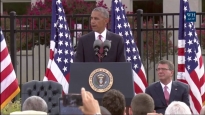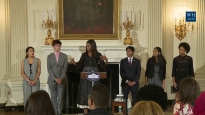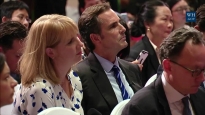First Lady Michelle Obama speaks at the Fashion Education Workshop
October 08, 2014 | 1:14:41 | Public Domain
On October 8, 2014, the First Lady delivered remarks at the Fashion Education Workshop at the White House.
Remarks by the First Lady at Fashion Education Workshop
East Room
12:49 P.M. EDT
MRS. OBAMA: Well, hello everyone. How are you doing?
AUDIENCE: Great.
MRS. OBAMA: Okay. All right, we’re just going to break this up one moment and just say, is this not cool? (Laughter.) I mean, come on. You’re in the White House. There are some of the most impressive people in fashion here to teach you all, and to reach out and to mentor you. And there’s food. (Laughter.) What more could you ask for.
Well, welcome to the White House. And let me start by thanking Anna for that very kind introduction and for her tremendous passion and leadership in making this day a reality. We started cooking this up a little while ago, and it’s just been a thrill to be able to bring this vision to reality. So, Anna, thank you so much.
I also want to thank everyone from the -- Parsons The New School for Design for helping us today, the Fashion Institute of Technology, the Pratt Institute of Technology, along with all of the incredible designers and entrepreneurs, the fashion journalists who have taken time out of their very busy days to be here with all of you. Let’s give them all a round of applause. (Applause.)
And there are two groups that I want to give special recognition to. First, all of the students and faculty from Parsons who created the incredible décor that you see here on the tables in the East Room. Well done. (Applause.) Thank you, guys. Thank you so much.
And second, I want to recognize the two winners of our design competition for this event. The dress that I am wearing today and the dress that you see here were designed by two students who are with us today. Chelsea Chen -- Chelsea, stand up, please. Chelsea designed this dress. (Applause.) Great job! (Laughter.) And Natalya Koval, please stand up. Natalya designed this dress. (Applause.) Well done. Oh, did it switch around? Natalya designed this dress, Chelsea designed that dress. Well done! (Laughter.) Good job! They’re both students at FIT. And Natalya and Chelsea, thank you. Thank you for your creativity, thank you for your passion. We’re very proud of you. I hope you had fun doing this. And I want to thank the designer mentors who helped them bring their ideas to life -- Phillip Lim and Lela Rose. Phillip and Lela, thank you both for working with Natalya and Chelsea today.
In these dresses that you see and this room, we see the incredible promise that lies within our next generation. And that’s really what today is all about -– it’s about all of you young people who are here in this room with us, and all the young people who couldn’t be in this room, and your dreams. We really do focus on how you’re going to get where you’re going to go. And that’s what this is all about.
I know that many of you are hoping to one day pursue a career in fashion, and that’s why we invited you here today -- because we want you to really understand what it’s going to take to be successful. And we want you to see firsthand that a solid education and the willingness to work hard is really at the core of what it’s going to take to achieve your goals: education and hard work. It’s that simple.
Today’s workshop is one in a series of events that we have done over the past six years for young people across the country. We have been doing this since the day we entered the White House for young people. We want them to be in this house and experience the things that they’re passionate about. And this workshop is one of many -- whether it’s music or dance or poetry, our mission is always the same: to inspire you guys to dream bigger, to reach higher, and then, most importantly, to pull somebody else up with you along the way.
Because your sitting in these seats makes you really special, but it doesn’t make you unique. Because you know for every kid that is sitting in this chair, you know probably 10 others who could be sitting in this chair. So that’s where the giveback comes in, because you’ve got to be thinking, “I was lucky and blessed to be here, so what am I going to do to share these gifts with somebody else?”
Now, when it comes to the fashion industry, so often people think it’s all about catwalks and red carpets and “who wore it best,” and whether some famous person wore the right belt with the right shoes –- like I’d know what that’s like. (Laughter.) But the truth is that the clothes you see in the magazine covers are really just the finished product in what is a very long very complicated and very difficult process, as I’ve come to learn working with many designers.
What most people don’t realize is that there are so many different aspects to this industry. Whether it’s business marketing or technology and manufacturing, even agriculture that produces the wool and the cotton that ultimately becomes our clothes, it’s a big, complicated industry. The industry is also a huge contributor to this economy. Last year alone, Americans spent more than $350 billion on clothing and footwear, and about 1.4 million American workers are employed annually by retailers and others in the fashion industry -- so a lot of jobs, a lot of income that is generated by many of the people who are sitting in this room.
But for so many of you –- whether you’re already in the industry or aspiring to be there some day -– I know that in the end, fashion is really about passion and creativity. Just like music or dance or poetry, it’s what drives you. It’s what gets you out of bed each morning. It’s what you write about in essays in school and what you read about in the news. It occupies every ounce of your daily lives. I know this because with creative people, that’s what their passion does -- it makes everything else worthwhile.
Fashion is about so much more than just a pretty pair of pumps or the perfect hemline. For so many people across the country, it is a calling, it is a career, and it’s a way they feed their families. So that’s why we thought it was important to bring the industry to the White House, and to share it with all of you who are coming up in the next generation.
Today, in your breakout sessions, you all have had a chance to see all the different aspects of the industry -- and there are many, many more aspects, we just didn’t have the time. But you learned the business sense that you need to strike out on your own. There’s a very entrepreneurial aspect to this industry. You learned the writing and verbal skills that you need to communicate your inspiration with others -- because the bottom line is that if you can’t share your thoughts and ideas, no one will hear them. There’s no mindreading in fashion design; you have to be able to articulate what you want. So you have to be a reader, a writer, a thinker, a communicator.
You learned the highly specialized construction skills that you all can only learn through hours and years of education and practice and technical training. This doesn’t just come out of just talent, sheer creativity. You have to practice it. You have to learn it. You have to study it. And those are the kind of concrete skills that you all will need to succeed. And it’s important for you all to know that there’s a concreteness to this work. And it’s easy to lose sight of that, because it’s easy for us to look at the accomplished people in this room and think, well, it must have been easy being Jason Wu -- Jason’s like, not so much -- (laughter) -- that the style and the creativity have just flowed from these people since the day they were born.
It’s easy to think that it’s easy. But these folks will tell you that that’s never really the case. What they have learned over the course of their illustrious careers is that the path to success is rarely ever easy or obvious. Instead, they know that in order to exceed, they know that you have to be prepared, that you’ve got to hone your skills in college or design school. You’ve got to be willing to take some risks, and you also have to be prepared to fail -- a lot.
All of these things are essential for the journey. And that’s true for fashion, but it’s true for everything else. Risks, failure, is a part of being great. So embrace that, don’t fear it. And the most important thing you’ve got to do is work and work and work and work and work and work. That’s it. It’s hard work -- sorry -- (laughter) -- years and even decades before you can achieve your goals.
Just take Sara Blakely, for example. After she graduated from college, Sara worked at Disney World, buckling in people into their seats for the rides -- dag, Sara. (Laughter.) Sara did that for a while, and then she went on to sell fax machines for an office supply company. And then she got this idea, and she took a risk -- she devoted her entire savings, $5,000, to start her own company.
She spent two years planning and researching her new business ideas in the nights while she was still selling fax machines. She pitched her idea to factories and mills, asking them to help her make the product a reality, and of course, she was turned down again and again and again. But finally, a manager at a factory liked her idea, and today, 14 years later, Sara’s idea, Spanx, is a multibillion-dollar company with products selling in more than 50 countries. (Applause.) And we all wear them with pride. (Laughter.)
And then there’s my friend Maria Cornejo, who grew up in Chile knitting and sewing clothes for her dolls. When she was 11, her family fled to England as political refugees. And Maria didn’t speak a word of English, and she says she always felt like an outsider. But then she realized that she could make a career out of fashion.
So she went to design school, and she studied fashion and textiles, and she started her own business. And today, Maria’s got a company based in New York. She won a National Design Award for fashion. She is one of my favorite designers. She’s earned fans all around the world. And she is probably one of the sweetest, most gracious people that I’ve met over the course of these years.
So to all of you guys in this room, I want those stories -- the stories of Sara and Maria, and I’m sure there are many, many others as you talk to people at your tables -- I want those stories to show you that there’s no magic to being successful in fashion or in anything else. What is required is a willingness to work long nights, to suffer through rejection and failure, to rise above all of that -- all the doubts and the fears and the anxieties -– whether you come from the city, the suburbs, no matter who you are, where you come from, all those feelings are natural. It’s a natural part of life.
Maybe you do feel like an outsider. Maybe you’ve been told that your ideas aren’t any good. Or maybe your family doesn’t have much money. Maybe you’re the first one in your family to go to college, and you’re wondering whether you’re even going to make it. Whoever you are, wherever you come from, I want you -- again, know that those worries and doubts are natural. It’s okay. Every single person in this room -- including me -- everyone who has been successful at anything has doubted themselves, and has had someone else doubt them.
But what successful people don’t do is let their doubts and fears shut them down. That’s what you cannot do. They brush off the doubters, they brush off the haters. They reach out for help, which is key. They use those emotions to inspire them to work even harder to create their own futures.
So today, I want you all of you to know that you belong here. You belong right here in the White House -- yes, yes. (Laughter.) So, look, you belong right here next to Jason Wu and Anna Wintour and Narciso -- and I could go on. You belong here. This is your home, so own it, okay? Because if you can sit at these tables and spend this day here and meet with all these great people, then you can do anything -- but you have to know that, and you have to tell yourselves that every single day. Remember this moment, and remember that the First Lady of the United States told you that you can do anything you want to.
And we’re counting on you. We are proud of you. Your President is proud of you. He knows this is going on, he’s just a little busy. (Laughter.) So I want you to take advantage of this day. I want you to network with each other. I want you to continue working hard, and know that failure is a part of the growth that you will need to be great.
So we are so pleased to have you here. And if you feel like this day was special, it’s because we think you all are special, and you all are worthy of the efforts that we’ve put in to making this day special for you. So thank you, guys. Thank you so much. (Applause.)
|
September 11, 2016
|
September 10, 2016
|
September 9, 2016
|
September 8, 2016
|
|
September 8, 2016
|
September 8, 2016
|
September 7, 2016
|
September 7, 2016
|
- &lsaquo previous
- …
- 24
- 25
- 26
- 27
- 28
- 29
- 30
- 31
- 32
- …
- next &rsaquo







